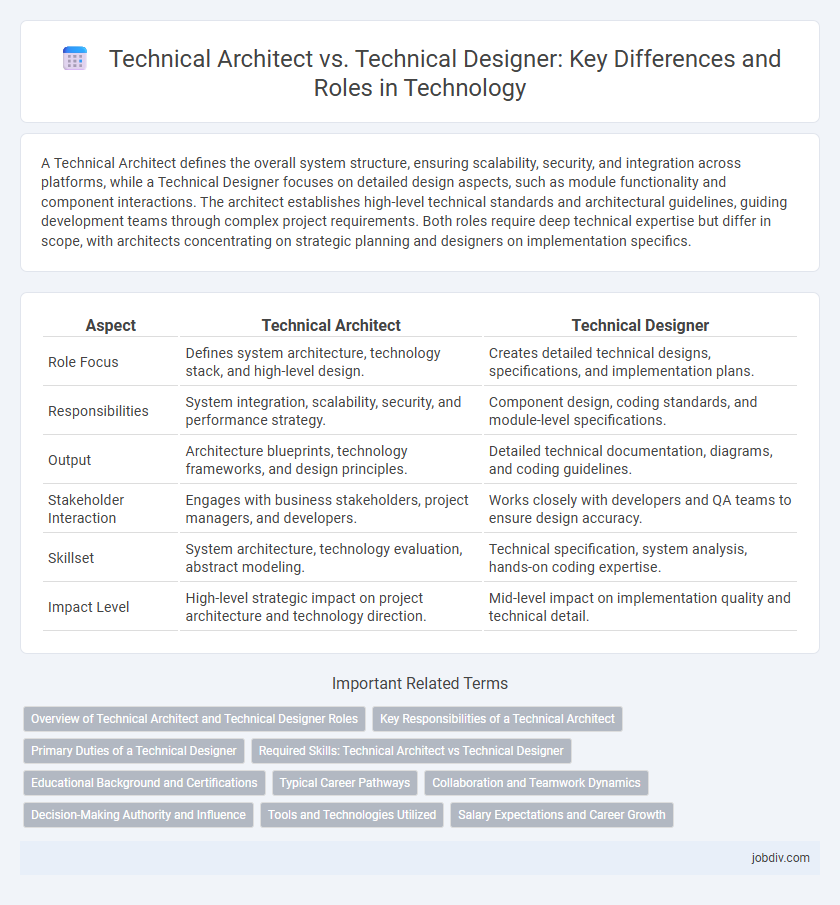A Technical Architect defines the overall system structure, ensuring scalability, security, and integration across platforms, while a Technical Designer focuses on detailed design aspects, such as module functionality and component interactions. The architect establishes high-level technical standards and architectural guidelines, guiding development teams through complex project requirements. Both roles require deep technical expertise but differ in scope, with architects concentrating on strategic planning and designers on implementation specifics.
Table of Comparison
| Aspect | Technical Architect | Technical Designer |
|---|---|---|
| Role Focus | Defines system architecture, technology stack, and high-level design. | Creates detailed technical designs, specifications, and implementation plans. |
| Responsibilities | System integration, scalability, security, and performance strategy. | Component design, coding standards, and module-level specifications. |
| Output | Architecture blueprints, technology frameworks, and design principles. | Detailed technical documentation, diagrams, and coding guidelines. |
| Stakeholder Interaction | Engages with business stakeholders, project managers, and developers. | Works closely with developers and QA teams to ensure design accuracy. |
| Skillset | System architecture, technology evaluation, abstract modeling. | Technical specification, system analysis, hands-on coding expertise. |
| Impact Level | High-level strategic impact on project architecture and technology direction. | Mid-level impact on implementation quality and technical detail. |
Overview of Technical Architect and Technical Designer Roles
Technical Architects define the overarching technology strategy, ensuring scalable system architecture and alignment with business goals by selecting appropriate technologies and frameworks. Technical Designers translate these architectural standards into detailed designs, specifying system components, interfaces, and technical specifications for development teams. Both roles collaborate closely to ensure coherent implementation, with Architects focusing on high-level structure and Designers on precise technical blueprints.
Key Responsibilities of a Technical Architect
Technical Architects lead the design and implementation of complex IT systems by establishing architectural frameworks, selecting appropriate technologies, and ensuring system scalability and security. They collaborate closely with stakeholders to translate business requirements into technical solutions, overseeing integration, performance optimization, and compliance with industry standards. Their key responsibilities also include risk management, technical decision-making, and guiding development teams throughout the project lifecycle to achieve robust and maintainable architectures.
Primary Duties of a Technical Designer
Technical Designers primarily focus on defining detailed design specifications, creating system architecture blueprints, and translating business requirements into technical solutions. They collaborate closely with developers and stakeholders to ensure design feasibility and technology integration. Their role emphasizes system modeling, documentation, and maintaining design consistency throughout the development lifecycle.
Required Skills: Technical Architect vs Technical Designer
Technical Architects require expertise in system architecture, cloud platforms, and integration frameworks to design scalable and robust solutions, along with skills in stakeholder management and strategic planning. Technical Designers need strong proficiency in software design patterns, coding languages, and detailed technical documentation to translate architectural vision into implementable modules. Both roles demand a deep understanding of software development life cycles and collaboration tools, but Architects emphasize high-level system vision while Designers focus on detailed technical specifications.
Educational Background and Certifications
Technical Architects typically possess advanced degrees in computer science, software engineering, or related fields, often complemented by certifications such as TOGAF, AWS Certified Solutions Architect, or Microsoft Certified: Azure Solutions Architect Expert. Technical Designers usually hold a bachelor's degree in information technology or software development, with certifications like Certified Software Design Professional (CSDP) or UML certification enhancing their expertise in system modeling and design patterns. Both roles benefit from continuous professional development through industry-recognized credentials to stay current with evolving technologies and methodologies.
Typical Career Pathways
Technical Architects typically progress from roles such as Software Engineer or Systems Analyst, advancing to Senior Developer before transitioning into architecture positions focused on solution design and system integration. Technical Designers often begin as Junior Developers or UX/UI Designers, specializing in detailed component design and user experience before moving into more strategic design leadership roles. Both career paths emphasize gaining deep technical expertise and cross-functional collaboration skills to drive effective technology solutions.
Collaboration and Teamwork Dynamics
Technical Architects establish system-wide architectural frameworks that guide development teams, while Technical Designers translate these frameworks into detailed design specifications and component-level solutions. Collaboration thrives through continuous communication, where architects align technical vision with business goals and designers address implementation feasibility and integration challenges. Effective teamwork dynamics depend on iterative feedback loops, ensuring seamless alignment between high-level architecture and granular design execution.
Decision-Making Authority and Influence
A Technical Architect holds primary decision-making authority over the overall system architecture, defining high-level structures and technology standards that guide project development. In contrast, a Technical Designer focuses on detailed design elements within the framework set by the architect, influencing component-level implementation and ensuring alignment with architectural guidelines. The architect's strategic influence shapes project direction, while the designer's tactical input refines technical solutions.
Tools and Technologies Utilized
Technical Architects primarily utilize enterprise architecture frameworks like TOGAF, cloud platforms such as AWS or Azure, and modeling tools including ArchiMate or Sparx Systems Enterprise Architect. Technical Designers focus on detailed design tools like UML modeling software, integrated development environments (IDEs) such as IntelliJ or Visual Studio, and configuration management systems like Git. Both roles require proficiency in scripting languages and API design to ensure seamless system integration and scalable architecture implementation.
Salary Expectations and Career Growth
Technical Architects generally command higher salary expectations than Technical Designers due to their strategic role in system architecture and project oversight, with average salaries ranging from $110,000 to $150,000 annually. Career growth for Technical Architects often leads to senior leadership positions such as Chief Architect or IT Director, while Technical Designers typically advance into specialized development or solution design roles with salaries between $80,000 and $120,000. Market demand favors Technical Architects for their broader impact on technology strategy, driving stronger long-term career progression and compensation potential.
Technical Architect vs Technical Designer Infographic

 jobdiv.com
jobdiv.com